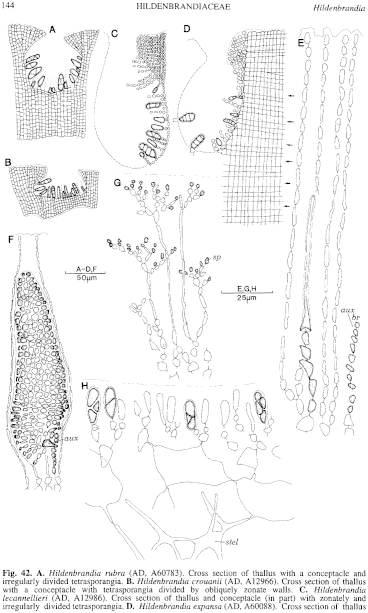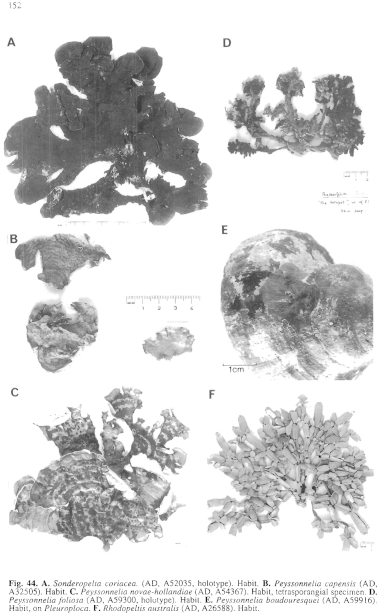|
|
|
|
|
|||||||||||
|
Electronic Flora of South Australia Species Fact Sheet
Phylum Rhodophyta – Class Florideophyceae – Order Gigartinales – Family Polyidaceae
Selected citations: De Toni 1905: 1671. Nozawa 1963: 35, fig. 12C–H; 1970: 121, fig. 14C–H. Schmitz & Hauptfleisch 1897: 530.
Synonyms
Amphiroa australis Sonder 1845: 55; 1848: 188. J. Agardh 1852: 537. Harvey 1849a: 98; 1859a: pl. 77. Kützing 1849: 703; 1858: 24, pl. 50a-d.
Cruoria australis Harvey 1855a: 551.
Litharthron australis (Sonder) Weber-van Bosse 1904: 104, pl. 15 figs 16, 17. Yendo 1905: 16.
Thallus (Fig. 44F) dark red-brown, fading to yellow-grey, 5–12 cm high and in spread, developing a terete to compressed, uncalcified stalk 1–3 mm in diameter, 1–7 cm long, knobby with branch remnants, bearing branches of 3–8 flat, ovate-elongate, heavily calcified segments, each bearing 2–4 branches terminally, separated by short, uncalcified nodes 0.5–1 mm in diameter; segments brittle, when mature 10–20 (–25) mm long, (3–) 4–8 mm broad and 200–600 km thick, decreasing in size near branch apices; segments with an apical and basal indentation adjacent to nodes and usually with two longitudinal lines corresponding to the thinner marginal cortical regions. Holdfast discoid-conical, 2–10 mm across; epilithic. Structure multiaxial, with a dense filamentous medulla and a cortex (Fig. 42H) of subspherical cells, the inner 40–50 µm in diameter, decreasing to the outer 3–4 µm in diameter; innermost cortical cells often stellate. Calcification (aragonite*) in the cell walls throughout the cortex, not the medulla, with numerous large starch grains in cortical cells.
Reproduction: Reproductive organs in uncalcified, ovate nemathecia on both sides of thallus segments. Sexual thalli dioecious. Female nemathecia 160–200 µm thick, with dense paraphyses 12–15 cells long, lower cells elongate, 2–3 µm in diameter, upper cells ovoid, broadening to 4–6 µm in diameter. Carpogonial branches (Fig. 42E) 6–8 cells long, cells 6–10 µm in diameter, L/D 1–2. Auxiliary cells apparently intercalary in filaments (Fig. 42E) similar to carpogonial branches. Gonimoblast filaments branched, carposporophytes (Fig. 42F) ovoid to elongate or lobed, 150–200 µm long and 60–100 µm in diameter, developing densely massed carposporangia, carposporangia more or less isodiametric, 6–10 µm in diameter. Male nemathecia (Fig. 42G) 80–120 nrn thick with slender multicellular paraphyses branching laterally to form tufts of ovoid spermatangia each 1–2 µm in diameter.
Tetrasporangial nemathecia (Fig. 42H) shallow, 30–40 µm thick, with short, unicellular paraphyses 15–20 µm long and 3–5 µm in diameter; tetrasporangia clavate to ovoid, 20–25 µm long and 8–10 µm in diameter, irregularly cruciately divided.
Type from Rottnest I., W. Aust. (Harvey); in Herb. Harvey, TCD.
Selected specimens: Strickland Bay, Rottnest I., W. Aust., 1–2 m deep (Clarke & Engler, 5.ix.1979; AD,
Distribution: Cottesloe and Rottnest I., W. Aust. to Point Roadknight, Vic.
Taxonomic notes: A51115). N Point Reef, Rottnest I., W. Aust. (Baird, Nov. 1945; AD, A4566). Waldegrave I., S. Aust., 23 m deep (Shepherd, 11.v.1971; AD, A38735). Elliston, S. Aust., 10–11 m deep in bay (Shepherd, 20.x.1969; AD, A34997). Pondalowie Bay, S. Aust., 5–8 m deep (Shepherd, 14.iv.1963; AD, A26588). Rapid Head, S. Aust., 10 m deep (Shepherd, March 1966; AD, A30482). Port Willunga, S. Aust., drift (Womersley, 24.iv,1948; AD, A8320). Cape du Couedic, Kangaroo I., S. Aust., 10 m deep (Shepherd, 24.x.1967; AD, A31970). Port Elliot, S. Aust., drift (Womersley, 24.vii.1949; AD, A11104). Point Roadknight, Vic., drift (Davis, 1.ii.1946; AD, A15518).
Rhodopeltis australis is the only segmented southern Australian red alga which is heavily calcified, apart from the geniculate Corallinaceae, and superficially resembles a broad Amphiroa. The structure and reproduction clearly separate it from the Corallinaceae_
References:
AGARDH, J.G. (1852). Species Genera et Ordines Algarum. Vol. 2, Part 2, pp. 337–720. (Gleerup: Lund.)
DE TONI, G.B. (1905). Sylloge Algarum omnium hucusque Cognitarum. Vol. 4. Florideae. Sect. 4, pp. 1523–1973. (Padua.)
HARVEY, W.H. (1849a). Nereis Australis, pp. 65–124, Plates 26–50. (Reeve: London.)
HARVEY, W.H. (1855a). Some account of the marine botany of the colony of Western Australia. Trans. R. Ir. Acad. 22, 525–566.
HARVEY, W.H. (1859a). Phycologia Australica. Vol. 2, Plates 61–120. (Reeve: London.)
HARVEY, W.H. (1863). Phycologia Australica. Vol. 5, Plates 241–300, synop., pp. i-lxxiii. (Reeve: London.)
KÜTZING, F.T. (1849). Species Algarum. (Leipzig.)
KÜTZING, F.T. (1858). Tabulae Phycologicae. Vol. 8. (Nordhausen.)
NOZAWA, Y. (1963). Systematic anatomy of the genus Rhodopeltis. Mem. Junshin Jun. Coll. 5, 1–48.
NOZAWA, Y. (1970). Systematic anatomy of the red algal genus Rhodopeltis. Pacif. Sci. 24, 99–133.
SCHMITZ, F. & HAUPTFLEISCH, P. (1897). Gelidiaceae, Acrotylaceae, Gigartinaceae, Rhodophyllidaceae, Sphaerococcaceae, Rhodymeniaceae, pp. 340–405, Grateloupiaceae, Dumontiaceae, Nemastomaceae, Rhizophyllidaceae, Squamariaceae, pp. 508–537. In Engler, A. & Prantl, K., Die nattirlichen Pflanzenfamilien. T. 1. Abt. 2. (Engelmann: Leipzig.)
SONDER, O.G. (1845). Nova Algarum genera et species, quas in itinere ad oras occidentales Novae Hollandiae, collegit L. Preiss, Ph.Dr. Bot. Zeit. 3, 49–57.
SONDER, O.W. (1848). Algae. In Lehmann, C., Plantae Preissianae. Vol. 2, pp. 161–195. (Hamburg.)
WEBER-VAN BOSSE, A. (1904). The Corallinaceae of the Siboga Expedition. Siboga-Expeditae, Monogr. LXI.
YENDO, K. (1905). A revised list of Corallinae. J. Coll. Sci., Imp. Univ. Tokyo 20 (12), 1–46.
The Marine Benthic Flora of Southern Australia Part IIIA complete list of references.
Publication:
Womersley, H.B.S. (14 January, 1994)
The Marine Benthic Flora of Southern Australia
Rhodophyta. Part IIIA, Bangiophyceae and Florideophyceae (to Gigartinales)
Reproduced with permission from The Marine Benthic Flora of Southern Australia Part IIIA 1994, by H.B.S. Womersley. Australian Biological Resources Study, Canberra. Copyright Commonwealth of Australia.
Illustrations in Womersley Part IIIA, 1994: FIGS 42 E–H, 44F.

Figure 42 enlarge
Fig. 42. A. Hildenbrandia rubra (AD, A60783). Cross section of thallus with a conceptacle and irregularly divided tetrasporangia. B. Hildenbrandia crouanii (AD, Al2966). Cross section of thallus with a conceptacle with tetrasporangia divided by obliquely zonate walls. C. Hildenbrandia lecannellieri (AD, Al2986). Cross section of thallus and conceptacle (in part) with zonately and irregularly divided tetrasporangia. D. Hildenbrandia expansa (AD, A60088). Cross section of thallus and conceptacle (in part) showing regular horizontal and vertical rows of cells, with horizontal layers of larger cells (arrows), and zonately divided tetrasporangia with paraphyses. E–H. Rhodopeltis australis (E, AD, A15518; F, AD, A8320; G, AD, A34997; H, AD, A38735). E. Section of female nemathecium with a carpogonial branch and an auxiliary cell branch among paraphyses. F. Section of a female nemathecium with a carposporophyte borne on an auxiliary cell. G. Section of a male nemathecium with spermatangial branches. H. Section of outer cortex (with inner stellate cells) with tetrasporangia among short paraphyses.

Figure 44 enlarge
Fig. 44. A. Sonderopelta coriacea. (AD, A52035, holotype). Habit. B. Peyssonnelia capensis (AD, A32505). Habit. C. Peyssonnelia novae-hollandiae (AD, A54367). Habit, tetrasporangial specimen. D. Peyssonnelia foliosa (AD, A59300, holotype). Habit. E. Peyssonnelia boudouresquei (AD, A59916). Habit, on Pleuroploca. F. Rhodopeltis australis (AD, A26588). Habit.

|
Email Contact: State Herbarium of South Australia |

|